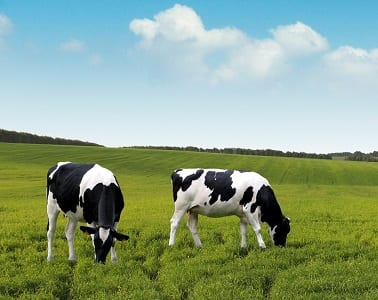We’re all told meat and dairy are ‘bad’ for the climate, and plant-based ‘good’ – right? While this may be true for conventional intensive farming, it’s not the whole picture.
There will always be so much more to food choices than carbon footprints, but given the growth in prominence of climate friendlier dining choices, it’s worth shining a spotlight on the growth of regenerative farming, as it seems to present a compelling case and has many committed advocates. Its role in decarbonising food supply chains was also highlighted in a recent Food and Drink Federation webinar on ‘Addressing the impacts of climate change’ (October 2023) – so mainstream awareness is growing fast.

Is the dairy debate too…black and white?
The term ‘regenerative’ sounds almost too good to be true – the idea that farming could be practised in a way that helps regenerate nature rather than contribute to its harm, and it has been clear for a while now that it’s not really understood or practised widely yet. The data to evidence this is still very much evolving, but the good news is that its adoption seems to be really gaining pace, which is fantastic; the more this is scaled up, the more data points we’ll have as an industry to benchmark against.
Some large food suppliers are realising that it makes good business sense to explore regenerative farming, as we all face an uncertain future when it comes to reliable food supply; we need to find ways to achieve net zero in food supply chains, in a way that doesn’t drive a whole host of unintended negative consequences.
The term ‘regenerative agriculture’ started to be used increasingly a couple of years ago in conversations about food production, and I was keen to understand more, because it’s increasingly clear that intensive farming is having a huge number of negative environmental impacts that all contribute to the climate crisis. Fertiliser over-use, run-off into rivers, soil degradation, biodiversity loss, the list goes on. I’d only heard this term ‘regenerative’ used in fairly niche contexts though; it was unclear whether it was scalable.

The principles of regenerative farming are to minimise soil disturbance, integrate livestock, protect the soil surface, encourage plant diversity and maintain living root systems. All these factors combine holistically to protect and build nutrients in the soil, sequester (store) carbon, help rainfall absorption, and enhance the living systems that contribute to the natural ecosystem processes.
If meat and dairy production is practised regeneratively (and that’s a big ‘if’!), then it can play an important role in addressing many environmental impacts – but the significance of its role in emissions mitigation is still much debated, given the ongoing production of methane emissions from grazing cattle. Champions of regenerative farming would argue that grazing cattle are the heroes, rather than villains of the climate debate, because carbon sequestration (absorption of carbon into soils, which varies hugely depending on farming techniques) and the wider contribution of grazing ruminants to biodiversity just aren’t factored into any existing emissions calculations.
Methane emissions from livestock are unavoidable, as they arise from the digestion and fermentation of cellulose from grass, but proponents of regenerative farming would argue that the methane produced is part of a carbon cycle ‘closed loop’ – an entirely natural process that is a distraction from the urgency of reducing fossil fuel consumption. If you’re interested in the science behind it, have a look at The Allerton Project, a research centre that focuses on building greater climate resilience into farming, whose partners include household names like Kelloggs and Nestlé. The Food Climate Research Network (FCRN) has also produced a very informative report called ‘Grazed and Confused?’ – weighing up and evaluating all the arguments associated with grazing cattle (FCRN, 2017).

I recently visited Howes dairy farm in Cumbria, to discover first-hand what regenerative dairy farming looks like, thanks to an innovative but long standing partnership between Nestlé and First Milk. The visit was organised in collaboration with Footprint Media, who have recently produced a report Is regenerative the future of farming? on accelerating the transition to regenerative farming in mainstream food production.
The day started with number crunching; according to their data, meat and dairy farmed regeneratively can have a lower carbon footprint than some plant-based milks, depending on how the plant-based milk is produced. The variations in carbon footprint are widely understood by many, but this complexity gets lost when product average footprints are referenced.
Average footprints definitely have a role to play, but there’s a risk that we stigmatise all meat and dairy, given that grazing livestock has an important role to play in healthy ecosystems. In Cumbria, they’re mob-grazing (a practice which emulates nature) on land which wouldn’t be suited to arable farming, so there’s no change in land use involved, and outside grazing is maximised.
According to Dairy vs. plant-based milk: what are the environmental impacts?, the typical carbon footprint of bovine milk is 3kg CO2e per litre, but First Milk members are producing milk in the region of 1kg CO2e per litre, and that’s before carbon sequestration into soils is factored in, which could mitigate those emissions by as much as 50%*. This puts their milk in the same GHG bracket as oat milk, below soya milk.

The farm tour prompted a lot of discussion with farmers, manufacturers, contract caterers and wholesalers alike; just how do we communicate the benefits of regenerative, even to the more conscious consumer, who is already faced with decisions around price, nutrition, calories, certifications, ethics and plastic packaging?
Should we even try to aim at the consumer, isn’t it more a case of convincing food manufacturers that they have a vested interest in protecting food supply for the long term? We were concerned about greenwashing around regenerative claims too – although hot off the press, just the day before, it was announced that consensus for a new standard in regenerative farming had been reached, see SAI Platform unveils global framework for regenerative agriculture..
Things are certainly moving fast in this area.
The panel discussion promoted further debate, from larger issues such as the role of DEFRA and government policy, to the challenges of influencing individual farmers to embrace regenerative practices. It’s really clear that the big players in the food industry need to understand the value of regenerative in terms of building resilience in food supply in a changing climate; ‘biodiversity loss and ecosystem collapse’ is viewed as one of the fastest deteriorating global risks over the next decade** – with ‘failure to mitigate climate change’ as no.1 top risk over the next ten years.
It’s apparent that regenerative farming could be a powerful lever of change, if we really embrace it in the food industry. The farmers we met in Cumbria were crystal clear that they just couldn’t have made the transition to regenerative systems without the commercial support and understanding by Nestlé and First Milk – things don’t change overnight.
The Sustainable Markets Initiative suggests that at least 40% of global farmland must transition to regenerative agriculture by 2030 to keep global warming to 1.5°C; currently only 15% of global farmland is managed using regenerative practices***. The FCRN report concludes that although grazing livestock have a role to play in healthy ecosystems, their role is limited. So, we should in Western societies, still focus on reducing meat and dairy consumption – and if/when we do eat meat and dairy, to make sure it comes from farms using regenerative practices.

It’s a challenging subject to raise in a cost of living crisis, with the hospitality and foodservice industry being so price sensitive, but as the Covid crisis showed us, it’s when you ignore the science that we really hit trouble, and for me the case for regenerative really does make sense.
So, how do we make the change? For me, it starts with awareness and knowledge, as the catalyst for change. This blog aims to raise awareness, and my aim is that this creates the impetus and desire for change. The next step is dialogue upstream in the supply chain; in wholesale we are only in the early stages of driving greater visibility within supply chains, as this information simply hasn’t been required by customers in the past. If we can demonstrate to manufacturers and their producers that there’s an appetite for regeneratively produced food, then the dialogue as to how to make this change can start.
For more information, please check out:
Farmer Richard Messenger discussing Nestlé partnership with Howe’s Farm to implement change here.
Responsible sourcing manager at First Milk, Lee Truelove, discussing the milk plan here.
Panel discussion and report summary here:
Hungry for more? Check out our related blogs:
- Journey to net zero – where do you start?
- How can the hospitality industry reduce food waste?
- What does Earth Day mean to Bidfood?
- 4 challenges with carbon labelling on menus
- How is Bidfood aiming to be a positive force for change?
- 3 reasons why we signed up to the Better Business Act coalition
*First Milk, 2023
**World Economic Forum, 2023
***Sustainable Markets Initiative, 2022



